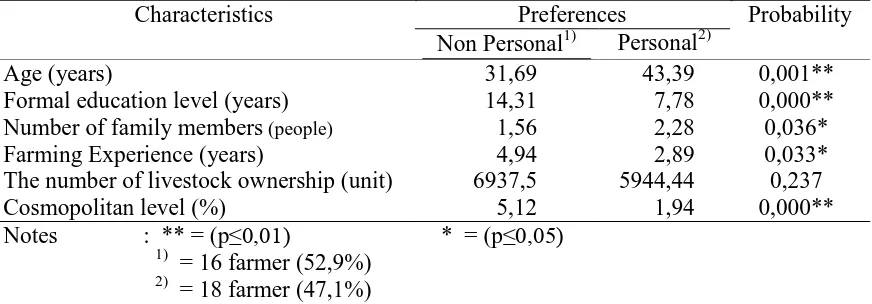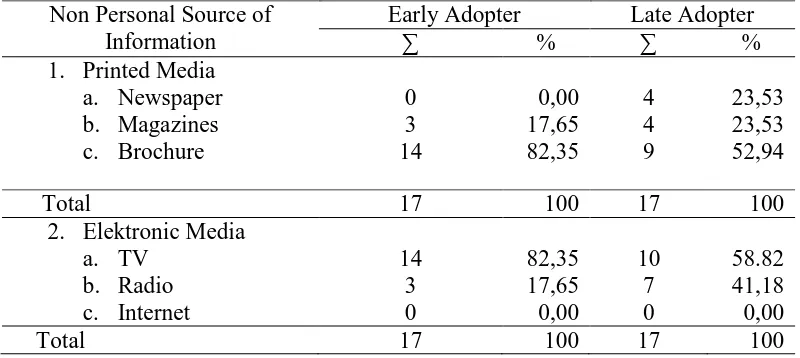Adopter Category And Preference Of Information Source On The Adoption Of Herbal Feed Additive On Broiler Farm
Ayu Intan Sari, S.Pt.,M.Sc
Department of Animal Science, Faculty of Agriculture, Sebelas Maret University, Surakarta
Email/telp : [email protected] / 081329621234
ABSTRACT
The first aim of this research is to analyze the effect of social economic characteristics and communication behavior of the farmer on the probability of adopter category differences and on the preference of source of information. The second aim is to analyze the effect of adopter category on the preference of source of information. This research has been conducted in the broiler farm at Karanganyar, Sragen, and Boyolali Central Java by using research based method of descriptive analysis. The result of the research shows that there are differences in social economic characteristics and communication behavior of the farmer between early and late adopter categories; they are age (p≤0.01), formal education level
(p≤0.01), cosmopoliteness level (p≤0.01), and
farming experience (p≤0.05). The result of logistic binominal regression test on social economic characteristics shows that age and formal education level influence the difference of adopter category significantly (p≤0.05). The characteristics of farmers have effect on the preferences of personal and non personal information source, namely age, formal education level, and cosmopoliteness level, which have significant effect (p≤0.05). Additionally, the result shows that the adopter category has very significant effect (p≤0.01) on the preference of information source. The conclusion of the research is that the younger farmers, higher formal education level, longer experience, and higher level of active searching information seemed to have higher
probability to become the early adopter. The farmers have higher preference on non personal information source.
Keywords: Adopter Category, information source, adoption, herbal feed additive
INTRODUCTION
There are some changes of food nutrition concept within food industry. It is developed from efforts to satisfy hunger into healthy life achievements which bring good effects such as improved food quality [6]. This improvement will emerge demand and consumption of product related to body health treatment and food consumption which positively contribute to human’s health [6]. Organic food is considered fulfill the requirements, therefore its demand and marketing opportunities increase steadily.
Innovation is a new idea, attitude, information, product and practice which have not known by the public yet, in which it cannot be accepted immediately and used in a short term. Society needs time to take decision whether to accept or reject the innovation. There are many factors which influencing innovation adoption process, they are the characteristics of the innovation itself, its target characteristics, decision making, communication media which are used, counselor condition, and source of information .
A proper marketing communication is needed in an adoption process to achieve an efficient and effective process objective [6]. Innovation can be well received by target through an information transmission process, that is through information communication media. In the process of a brand new product, marketing communication is developed to introduce product by emphasizing the attribute and benefits of the product, therefore, a selection of information has to be selective and adjusted to the targets’ needs in order to fulfill the marketing communication purposes. Each individual with her / his characteristics will be selective in choosing the right information source. Besides, each adopter also has various preference toward source of information. This research is aimed to analyze the socio-economic characteristics and communication behavior of the farmers toward source of information preference and to analyze the influence of adopter categories toward innovation source of information preference herbal feed additive for broiler.
RESEARCH METHODS
This research was conducted in the broiler farm at Karanganyar, Sragen, and Boyolali, Central Java by using research based method of descriptive analysis. Innovation of
herbal feed additive which used in this study is Formula Integral Organik Ternak (FIOT) production by PT. Naturaid. The respondents of the research were 34 farmers selected by using convinence sampling. The sample of this study was the farmers who still maintaining the broiler and use innovation FIOT as a feed additive during data collection. Evaluation of the adoption of innovations in the study was conducted over one year since the product launch. Farmers who have adopted the innovation of herbal feed additives before six months after the product was launched in the category of early adopters, and farmers who adopted six months after the product launch then put in a late adopter category. The data were analyzed using descriptive analysis, mann-whitney analysis, and logistic binominal regression analysis
Preference of information sources based on adopter categories were analyzed by binomial logistic regression, the analysis used to determine the probability and effect of several independent variables with two categories of the dependent variable [3]. Differences in information source preferences of farmers in each adopter category were analyzed using mann-whitney different test.
RESULTS AND DISCUSSION
TABLE 1. CHARACTERISTICS OF SURVEY RESPONDENTS
Variable Average
Age (years) Formal education level (years) Number of family members (people) Farming Experience (years)
The number of livestock ownership (unit) Cosmopolitan level (%)
- High levels cosmopolitan
- Low levels of cosmopolitan
37,88 10,85 1,91 3,85 6411,77
47,06 52,94
Individuals within a social group will adopt the innovation are not all at the same time but in a different time. Each individual can be classified based on their first apply an idea or new product [4]. The results show that 50% of respondents included in the early adopter category and 50% are categorized in a late adopter, where early adopter in this study include innovators, early adopters and early majority, while the late adopter include late majority and laggards.
The results of mann whitney different test show that there are real differences in these variables of the socioeconomic characteristics of the communication behavior of farmers based on personal preferences and information sources non personal (Table 2). The analysis show that the variables age, level of formal education, as well as different levels of cosmopolitan highly significant (p ≤ 0.01). Variable number of families involved in farming activities and farming experience significantly different (p ≤ 0.05).
TABLE 2. THE RESULTS OF THE MANN-WHITNEY DIFFERENT TEST SOCIO-ECONOMIC CHARACTERISTICS AND COMMUNICATION BEHAVIOR OF FARMERS BASED ON THE PREFERENCES OF INFORMATION SOURCES
Characteristics Preferences Probability
Non Personal1) Personal2) Age (years)
Formal education level (years) Number of family members (people) Farming Experience (years)
The number of livestock ownership (unit) Cosmopolitan level (%)
31,69 14,31 1,56 4,94 6937,5 5,12
43,39 7,78 2,28 2,89 5944,44 1,94
0,001** 0,000** 0,036* 0,033* 0,237 0,000** Notes : ** = (p≤0,01) * = (p≤0,05)
[image:3.595.69.505.499.651.2]TABLE 3. THE NUMBER OF RESPONDENTS AND THE RESULTS OF MANN-WHITNEY DIFFERENT TEST PREFERENCE RESOURCES BY ADOPTER CATEGORY
Variable Source of Information
Personal Non Personal
Early Adopter Late Adopter
2 16
15 1 Notes : probability value = 0,000 (p≤0,01)
Source of communication which used in distributing information consists of mass communication (non personal) and face to face communication (personal). Farmer as the information receiver will give responses to show whether he/she likes or dislikes the
source of information. Any response in a form of like and dislike is called preferences. Related to the source of information, farmers have different preferences toward source of information both personal and non personal sources (Table 4&5).
TABLE 4. PREFERENCE OF FARMERS TO PERSONAL SOURCE OF INFORMATION BY ADOPTER CATEGORIES
Personal Source of information Early Adopter Late Adopter
∑ % ∑ %
1. Extension agents 2. Sales
3. Other Breeders
4. Chairman of the farmer groups
8 5 2 2
47,06 29,41 11,76 11,76
3 7 5 2
17,65 41,18 29,41 11,76
Total 17 100 17 100
TABLE 5. PREFERENCE OF FARMERS TO NON-PERSONAL SOURCES OF INFORMATION BY ADOPTER CATEGORIES
Non Personal Source of Information
Early Adopter Late Adopter
∑ % ∑ %
1. Printed Media a. Newspaper b. Magazines c. Brochure
0 3 14
0,00 17,65 82,35
4 4 9
23,53 23,53 52,94
Total 17 100 17 100
2. Elektronic Media a. TV
b. Radio c. Internet
14 3 0
82,35 17,65 0,00
10 7 0
58.82 41,18 0,00
Characteristics of farmer will determine their efforts in gaining information and influencing their level of understanding. According to [1] one’s selectivity in choosing
and using source of information is depend on social classification which consist of age, education level, and income level.
TABLE 6. THE RESULTS OF BINOMIAL LOGISTIC REGRESSION ANALYSIS, THE
INFLUENCE OF SOCIOECONOMIC CHARACTERISTICS AND
COMMUNICATION BEHAVIOR OF FARMER’S PREFERENCES TOWARD SOURCE OF INFORMATION WITH THE FORWARD STEPWISE METHOD (LIKELIHOOD RATIO)
Independent Variable β E(β) Sig
Age
Formal Education Level Cosmopolitan Level
-0,239 0,513 0,512
0,788 1,670 1,669
0,020* 0,045* 0,044*
Constanta -3,029 0,048 0,322
R2 76,5
Chi-square Models 0,000**
Notes : ** = significant level 99% * = significant level 95%
Table 6 shows that the socioeconomic characteristics of the variables of age, level of formal education, communication and behavioral variables in the form of a cosmopolitan level significantly affected the preferences of personal and non personal source of information (p ≤ 0.05). The result shows that age variable has negative effects toward non personal source of information; this shows that person who has younger age prefer to seek information from non personal source, such as printed media (newspaper, magazines, brochure) and electronic media (TV, radio, and internet).
Formal education level and farmer cosmopolitan level have positive effects toward non personal source. This finding shows that longer one engaged in education and higher one’s cosmopolitan level, they tend to choose non personal source. This condition inline with [3] in his study suggested that education level has significant effect toward preference in choosing communication channel.
TABLE 7. THE RESULTS OF BINOMIAL LOGISTIC REGRESSION ANALYSIS THE INFLUENCE OF ADOPTER CATEGORIES TOWARD INFORMATION SOURCE PREFERENCE TO ENTER METHOD
Independent Variable β E(β) S ig
Adopter 4,787 120,00 0,000**
Constanta -2,773 0,063 0,007
R2 91,20
Chi-square Models 0,000**
Table 7 shows that the adopter categories highly significant effect (p≤ 0.01) of farmers preferences toward personal and non personal source of information. Effects of adopter category toward information source preference is positive, this result shows that farmer included into early adopter since they like non personal source. This condition related to the characteristic owned by the early adopter, in which these adopter are very open minded to any innovation and changes. Therefore, a non personal media is enough to ensure them. Reference [4] stated that among early adopter category, mass media is more important than personal source and vice versa in late adopter.
CONCLUSION
The conclusion of the research is that younger farmers, higher formal education level, longer experience, and higher level of active searching information seemed to have higher probability to become the early adopter. The farmers have higher preference of non personal information source.
REFERENCES
[1] Depari, E dan M.A. Colin. 1995. Peranan Komunikasi Massa Dalam Pembangunan. Gadjah Mada University Press, Yogyakarta
[2] Mardikanto, T. 1993. Penyuluhan Pembangunan Pertanian. Sebelas Maret University Press, Surakarta
[3] Rinasmoko, B. 2005. Faktor-Faktor Yang Berpengaruh Terhadap Pemilihan Ragam Saluran Pemasaran. Skripsi S-1. Fakultas Pertanian UGM, Yogyakarta
[4] Rogers, E.M. 1995. Diffusion of Innovation. 4th ed., The Free Press, New York
[5] Santosa, P.B. dan Ashari. 2005. Analisis Statistik Dengan Microsoft Exel dan SPSS. Penerbit Andi, Yogyakarta

